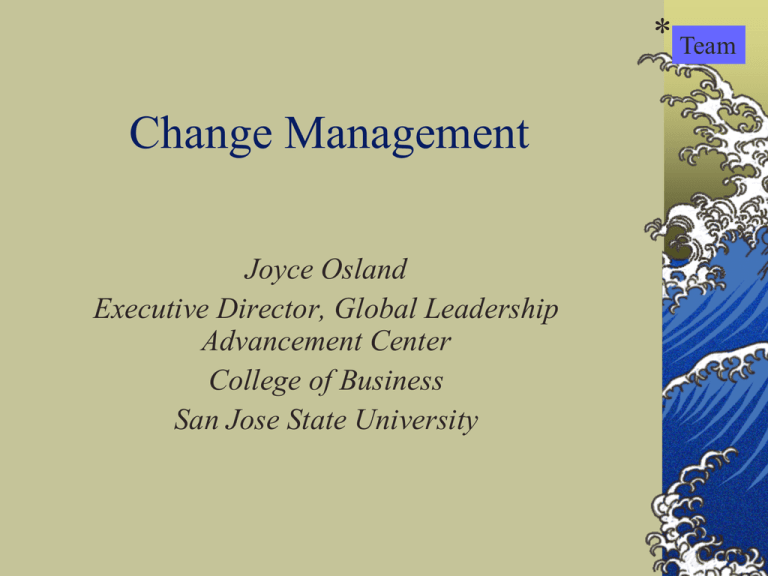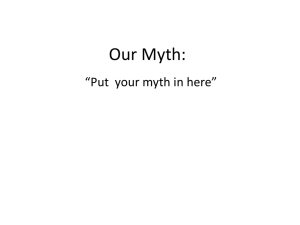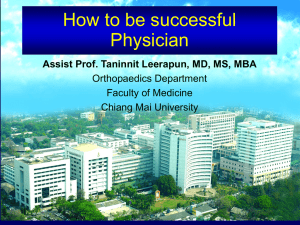presentation
advertisement

* Team Change Management Joyce Osland Executive Director, Global Leadership Advancement Center College of Business San Jose State University How many change programs succeed? Only 30%! How many of you made a New Year’s Resolution? How many of you are succeeding at it? Myth #1 CRISIS IS A POWERFUL IMPETUS FOR CHANGE REALITY: Ninety percent of patients who’ve had coronary bypasses don’t change their unhealthy lifestyles even though they know their lives are threatened. Myth #2 CHANGE IS MOTIVATED BY FEAR REALITY: It’s too easy for people to go into denial of the bad things that might happen to them. Compelling, positive visions of the future are a much stronger inspiration for change. Myth #3 THE FACTS WILL SET US FREE REALITY: Our thinking is guided by narratives, not facts. When a fact doesn’t fit our conceptual “frames” (the metaphors we use to make sense of the world) we reject it. Change is inspired best by emotional appeals rather than factual statements. Myth #4 SMALL, GRADUAL CHANGES ARE ALWAYS EASIER TO MAKE AND SUSTAIN REALITY: Radical sweeping changes are often easier because they quickly yield benefits. Myth #5 WE CAN’T CHANGE BECAUSE OUR BRAINS BECOME “HARDWIRED”EARLY IN LIFE REALITY: Our brains have extraordinary “plasticity,” meaning that we can continue learning complex new things throughout our lives—assuming we remain truly active and engaged. What have you learned about change from your own experience in organizations? What questions do you have about managing change? Nature of Organizational Change Means reexamining basic assumptions Involves a mourning period for old ways New behavior leads to new attitudes Process of unfreezing, moving, refreezing Too much change is disturbing Unpredictable; may result in unanticipated consequences Difficult but not impossible Four Basic Conditions Needed for Change Compelling story – buy-in Role modeling – lead by example Reinforcing mechanisms – aligned systems, processes, incentives Capability building – training/buying the skills needed to make the change Compelling Story – How Human Nature Gets in the Way 1. What motivates you doesn’t motivate most of your employees You’re better off letting them write their own story It takes a story with both + and – to motivate them Role Modeling – How Human Nature Gets in the Way Leaders mistakenly believe that they already “are the change” Influence leaders aren’t a panacea for making change happen Reinforcing Mechanisms – How Human Nature Gets in the Way Money is the most expensive way to motivate people The process and the outcome have to be fair Capability Building – How Human Nature Gets in the Way Employees are what they think, feel, and believe in Good intentions aren’t enough Conditions Favorable for Change C=(D X S X P) > X Where... C = change D = dissatisfaction with status quo S = an identifiable and desired end state P = practical plan for achieving the desired end state X = the cost of change to the organization Change is a process, not an edict. Goal/ Solution Process Stages in the Change Process Increase Urgency Make Change Stick Build the Guiding Team Don’t Let Up Get the Vision Right Create ShortTerm Wins Communicate for Buy-In Empower Action











